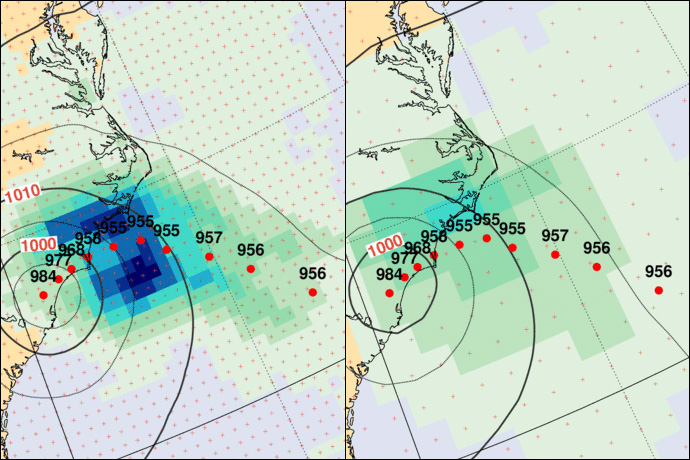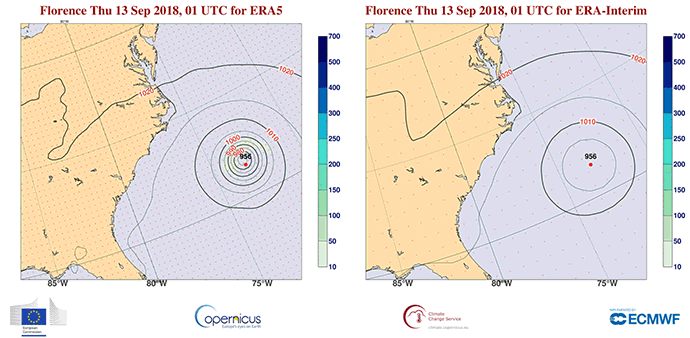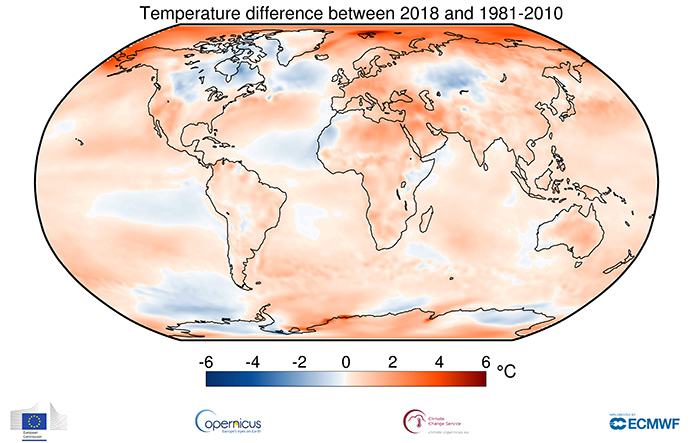

ECMWF’s new atmospheric reanalysis, ERA5, provides a detailed picture of the global weather and climate back to 1979 after the Copernicus Climate Change Service (C3S), implemented by ECMWF on behalf of the EU, released the latest tranche of ERA5 data. This innovative dataset will eventually go back all the way to 1950.
Atmospheric reanalysis combines a weather model with observational data from satellites and ground sensors to build a complete and consistent long-term record of our weather and climate.
Reanalysis datasets are used for climate monitoring, climate studies and meteorological research, and they underpin an increasing variety of sectoral applications. They also support numerical weather prediction, for example by providing a reference against which the quality of forecasts from successive model versions can be compared.
ERA5 is openly accessible via the C3S Climate Data Store. It contains estimates of variables such as air temperature, pressure and wind at different altitudes, rainfall, soil moisture content and ocean wave height. ERA5 replaces ECMWF’s previous atmospheric reanalysis, ERA-Interim, which also covers the period from 1979 to the present. ERA-Interim will remain available to users, but no further data will be added after mid-2019.

The ERA5 reanalysis provides a detailed picture of the track, intensity (contours, in hPa) and accumulated rainfall (shading, in mm) associated with Hurricane Florence as it struck the east coast of the US in September 2018 (left). Its predecessor, ERA-Interim, provides a less accurate and less detailed picture as it uses an older model version, fewer observations and a lower spatial and temporal resolution (right).
Compared to ERA-Interim, ERA5:
- benefits from 10 years of improvements in numerical weather prediction (it uses Cycle 41r2 of ECMWF’s Integrated Forecasting System, implemented in March 2016)
- uses improved historical observations, boundary conditions and external forcing
- provides hourly information at a grid spacing of around 31 km globally and 137 levels in the vertical, up from six-hourly fields at a grid spacing of 79 km and 60 levels in ERA-Interim
- includes uncertainty information by providing an ensemble of 10 reanalyses.
Reanalysis has long been a research activity at ECMWF, notably as part of the EU-funded, collaborative ERA-CLIM and ERA-CLIM2 research projects. The implementation of C3S by ECMWF on behalf of the EU has now turned reanalysis into a sustainable operational service.
The production of ERA5 data back to 1950 will be complete by the end of this year.
Fourth warmest year
The power of reanalysis is illustrated by the latest ERA-Interim results, which show that 2018 was the fourth-warmest year on record.

Two-metre temperature anomalies for 2018 relative to the 1981–2010 average, based on ERA-Interim data. Source: Copernicus Climate Change Service, ECMWF
The C3S data show that:
- The global average surface air temperature in 2018 was 14.7°C, 0.2°C lower than in 2016, the warmest year on record.
- The last four years have been the warmest four on record, with 2018 being the fourth warmest, not far short of the temperature of the third warmest year, 2015.
- 2018 was more than 0.4°C warmer than the 1981–2010 average.
- The average temperature of the last 5 years was 1.1°C higher than the pre-industrial average (as defined by the IPCC).
- Europe saw annual temperatures less than 0.1°C below those of the two warmest years on record, 2014 and 2015.
Additional data, provided by the Copernicus Atmosphere Monitoring Service (CAMS) implemented by ECMWF on behalf of the EU, show that CO2 concentrations continued to rise in 2018, increasing by 2.5 +/- 0.8 ppm/year.
“The Copernicus Climate Change Service provides quality-assured data of climate indicators like surface temperature, sea-ice cover and hydrological variables like precipitation,” said Head of C3S Jean-Noël Thépaut.
“In 2018, we have again seen a very warm year, the fourth warmest on record. Dramatic climatic events like the warm and dry summer in large parts of Europe or the increasing temperature around the Arctic regions are alarming signs to all of us. Only by combining our efforts can we make a difference and preserve our planet for future generations.”
